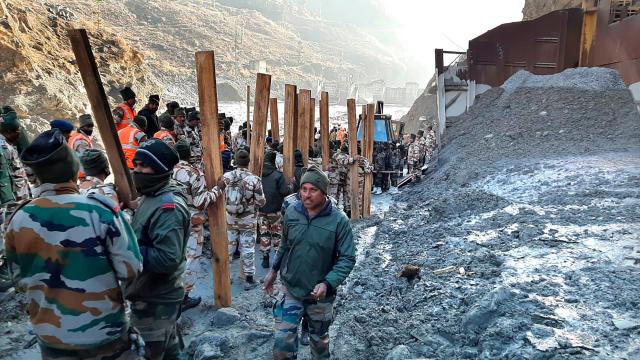At least 20 people are dead and up to 125 still missing after a piece of a glacier in the Himalayas collapsed on Sunday, causing flash floods and destroying a dam in its path. Video footage shows a colossal rush of water and rocks roaring through a mountain valley in the northern Indian state of Uttarakhand after a portion of the Nanda Devi Glacier broke off into a nearby river.
Many of the casualties were workers at two hydropower plants in the region, and officials said as many as 35 people are still trapped in tunnels at one of the plants further downstream. Rescue crews are hard at work attempting to free those still trapped.
“There is a huge amount of debris and slush in front of the tunnel,” Vivek Kumar Pandey, a spokesperson for the Indo-Tibetan Border Police, told media. “We are using earthmovers and excavators to remove it.”
The Himalayan region is one of the world’s most impacted by climate change. A study published in 2019 warned that glaciers in the Himalayas were melting twice as fast since 2000 as they did in the previous century. Another 2019 study found that the water stored in the Himalayas ice is among the most imperiled in the world due to the compounding pressures of climate change and increased demand for hydropower and agriculture.
While researchers are still investigating the cause of the glacier fracturing apart, there are signs that heavy snowfall followed by sunny weather caused a slew of meltwater that began the process, according to Reuters. Sunday’s collapse “looks very much like a climate change event,” Anjal Prakash, a professor at the Indian School of Business in Hyderabad who served on the UN’s Intergovernmental Panel on Climate Change, told the Washington Post. “The glaciers are melting due to global warming.”
Climate change is making living in the shadow of ice more risky. As glaciers have receded, they’ve left behind lakes behind unstable earthen dams where known as moraines. Research indicates these moraines made of glacial till are likely fail with increasing regularity in the coming century. As if to underscore that research, findings published last week have tied climate change to the risk at a specific glacier lake in Peru. A series of monster 2016 avalanches in Tibet was also tied with rising temperatures in the region.
The current calamity isn’t Uttrakhand’s first brush with climate disaster. In 2013, the state experienced several days of devastating floods and landslides after heavy rainfall struck the region, killing more than 1,000 people. The unusually heavy precipitation, combined with floods of rocks and water from what were likely glacier breakoffs higher in the mountains, devastated a a heavily trafficked area for tourists with largely uncontrolled construction and few regulations or warning systems put in place by the local government. For residents of the region, this latest disaster immediately brings back what happened in 2013.
“The first thing that came to my mind after seeing the swollen river was the Kedarnath tragedy which swallowed thousands of lives,” Rakesh Dhimri, who lives in a village near the hydropower plant, told the Hindustan Times. “My family and I were just praying to God to protect us from similar possible tragedy. Fortunately, we were saved but the workers on the dam site were not so lucky.”
Residents of Dhimri’s village filed complaints with local authorities about the potential dangers from the hydropower plant and its associated waste nearly two years ago.
